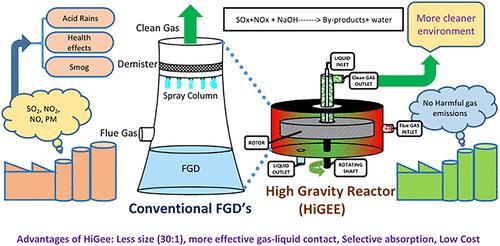利用高重力反应器同时去除SOx和NOx
IF 3.9
3区 工程技术
Q2 ENGINEERING, CHEMICAL
引用次数: 0
摘要
在城市化和工业化不断发展的时代,空气污染的后果变得越来越普遍和令人担忧。我们呼吸的空气曾经被认为是一种无限的资源,现在却充满了对人类健康构成重大风险的污染物。空气污染物的主要来源包括硫氧化物(SOx)、氮氧化物(NOx)和颗粒物(PM),它们都来自工业运营和汽车排放,对环境和人体健康极其有害。虽然有传统的清理方法,但HiGee技术提供了更有效的污染物捕获。以某燃煤电厂烟气为研究对象,采用高重力变孔隙填料反应器处理烟气。在不同的操作条件下,如转子转速(rpm)、碱加药速率、气液流速等,碱溶液起吸收介质的作用。高离心力和更好的气液接触可以增强传质,这是几乎完全消除SOx和NOx的原因。此外,实现了大量减少PM和选择性吸收,突出了HiGee技术在烟气处理中的潜力。本文章由计算机程序翻译,如有差异,请以英文原文为准。

Simultaneous Removal of SOx and NOx Using a High-Gravity Reactor
In an era where urbanization and industrialization are on the rise, the consequences of air pollution have become increasingly prevalent and concerning. The air we breathe, once considered to be a limitless resource, is now laden with pollutants that pose significant risks to human health. The main sources of air pollutants include sulfur oxides (SOx), nitrogen oxides (NOx), and particulate matter (PM), which are all extremely harmful to the environment and human health and emerge from industrial operations and automobile emissions. Although there are traditional cleanup methods, HiGee technology provides more effective pollutant capture. Flue gases from a coal-based power station were treated in this study using a high-gravity reactor installed with variable porosity packing. Under various operating conditions, such as rotor speed (rpm), caustic dosing rate, and gas–liquid flow rates, a caustic solution functioned as the absorbent medium. High centrifugal forces and better gas–liquid contact allowed for enhanced mass transfer, which was responsible for the results’ near-complete elimination of SOx and NOx. Furthermore, substantial PM reduction and selective absorption were achieved, highlighting the potential of HiGee Technology in flue gas treatment.
求助全文
通过发布文献求助,成功后即可免费获取论文全文。
去求助
来源期刊

Industrial & Engineering Chemistry Research
工程技术-工程:化工
CiteScore
7.40
自引率
7.10%
发文量
1467
审稿时长
2.8 months
期刊介绍:
ndustrial & Engineering Chemistry, with variations in title and format, has been published since 1909 by the American Chemical Society. Industrial & Engineering Chemistry Research is a weekly publication that reports industrial and academic research in the broad fields of applied chemistry and chemical engineering with special focus on fundamentals, processes, and products.
 求助内容:
求助内容: 应助结果提醒方式:
应助结果提醒方式:


